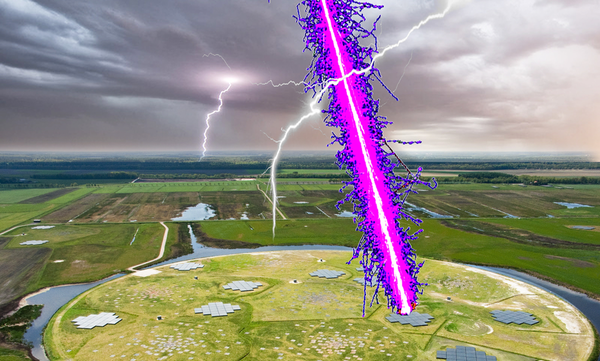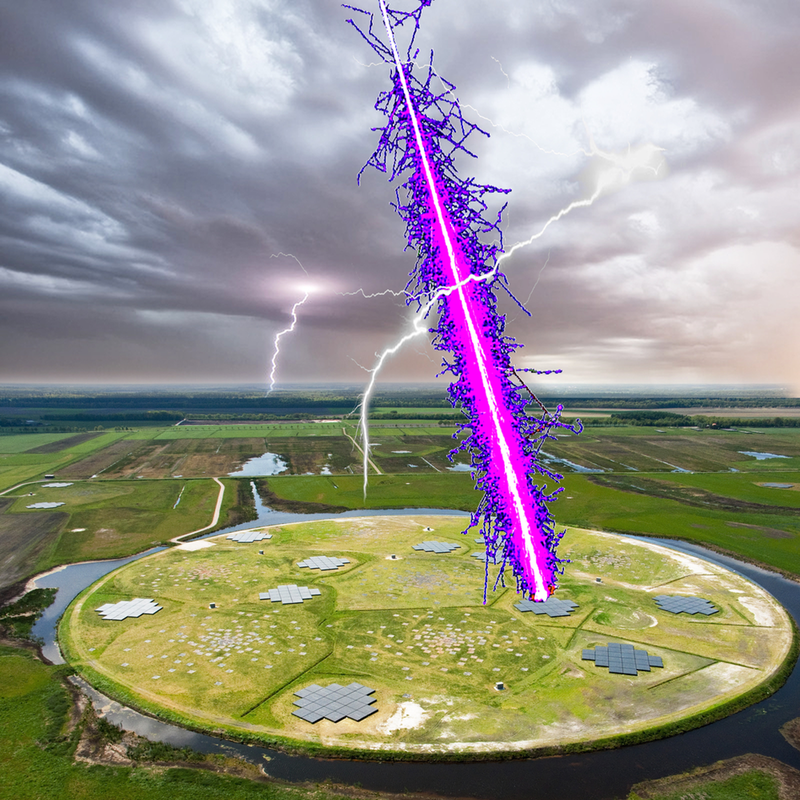Cosmic Rays as Thunderstorm Probes
Atmospheric scientists still don’t have a complete understanding of lightning, in part because it’s difficult to measure electric fields in thunderstorms. Now a large, international collaboration of scientists has demonstrated a new way to take a snapshot of atmospheric electric fields. They used detectors designed for astronomy to measure radio waves produced during cosmic-ray showers that occurred in thunderstorms. The team deduced a two-layer structure of thunderstorm electric fields, an idea that has been proposed but never clearly observed.
Most existing measurements of thunderstorm electric fields are made using airborne instruments, carried by balloons, for example. But one only gets measurements along the flight path, which in the case of a balloon can’t be controlled anyway. And the presence of a balloon or other aircraft disturbs the field, even to the point of attracting a lightning strike—which might destroy a balloon and its payload.
There have been proposals to use cosmic-ray air showers as probes of atmospheric electric fields, but now Heino Falcke of the University of Nijmegen in the Netherlands and his Ph.D. student Pim Schellart, along with a group at the University of Groningen and a large, international team of collaborators, have demonstrated this approach. The basic idea is that cosmic rays—fundamental particles such as protons or gamma-ray photons streaming through space—can produce a shower of electrically charged particles in the atmosphere, which generates radio waves as the particles move in the Earth’s magnetic field. Large electric fields from thunderstorms can disturb the motion of these secondary particles in a distinctive way that leaves an imprint on their radio emissions and allows the field strength and direction to be deduced.
There are two ways in which the charged secondary particles are produced by cosmic rays. High-energy gamma rays can decay into pairs of electrons and positrons (anti-electrons); and cosmic rays can collide with atmospheric atoms and kick out electrons. Each of these charged products will create a radio-frequency pulse as it moves in the geomagnetic field. In general, the radio waves are polarized in a direction that depends on the relative orientation of the particles’ motion and the magnetic field.
But the particle trajectories in the shower might be altered by strong atmospheric electric fields, for example during a thunderstorm. The signature of such high fields is a difference between the predicted direction of radio wave polarization, based on the known orientation of the shower, and the observed polarization direction.
To observe the radio wave polarization, Schellart and colleagues made use of the LOFAR (Low Frequency Array) radio telescope network, an array of simple radio antennas centered in the north of the Netherlands but also including several other European countries. LOFAR is operated by the Netherlands Institute for Radio Astronomy, ASTRON.
In fair-weather conditions, simulations of the polarization patterns of cosmic-ray-shower radio emissions perfectly matched those measured by the Dutch array (the team collected no data from other countries). But when there were thunderstorms within a few hundred kilometers, the polarization was different from what was predicted—unless the researchers added atmospheric electric fields into the calculations. They saw this kind of discrepancy for 31 out of 762 air showers, 20 of which coincided with lightning strikes appearing within 150km of the array.
To reproduce the data, the researchers needed to add to their calculations a two-layered structure, where the fields of the upper and lower layers pointed in opposite directions. This sort of layered field has been proposed before as a result of the arrangement of charges in a thundercloud, but team member Anna Nelles of Nijmegen says that the technique now provides “the first instantaneous cross-section of the electric field through a cloud.” The measurements imply field strengths of around 50 kilovolts per meter in the upper layer, and about half that in the lower layer.
“Thunderstorm electric fields have been tricky to measure, and there is a lot of uncertainty about how big the fields can get,” says lightning expert Joseph Dwyer of the Florida Institute of Technology. This uncertainty, he says, hinders an understating of how lightning gets started inside the clouds. “Having a technique like this to remotely measure the electric field is very useful and may help us make progress in understanding thunderstorms and lightning.”
This research is published in Physical Review Letters.
–Philip Ball
Philip Ball is a freelance science writer in London. His latest book is How Life Works (Picador, 2024).





